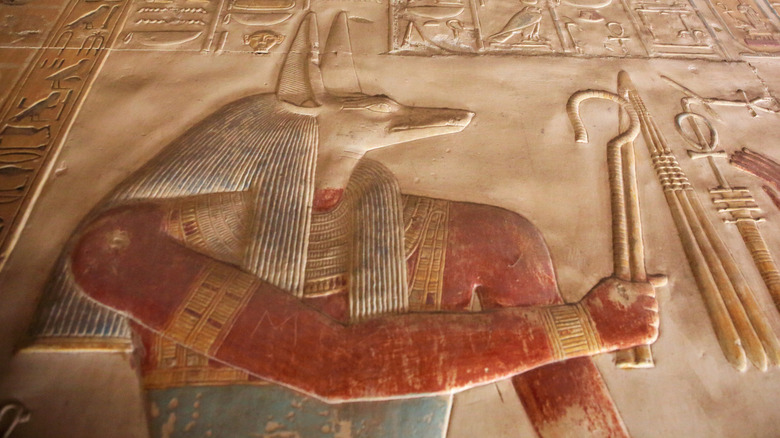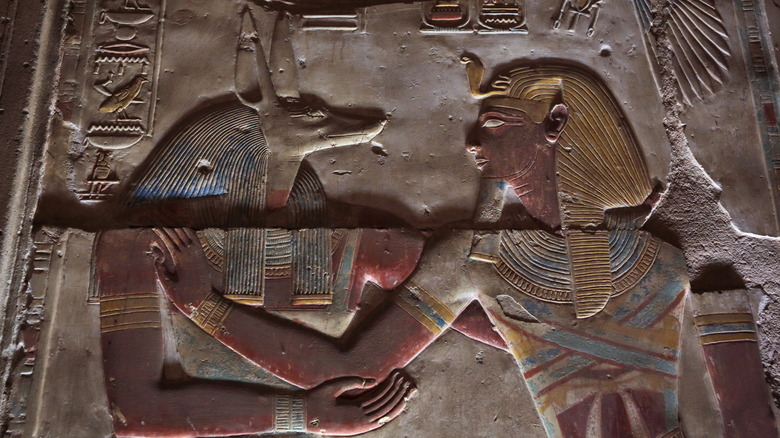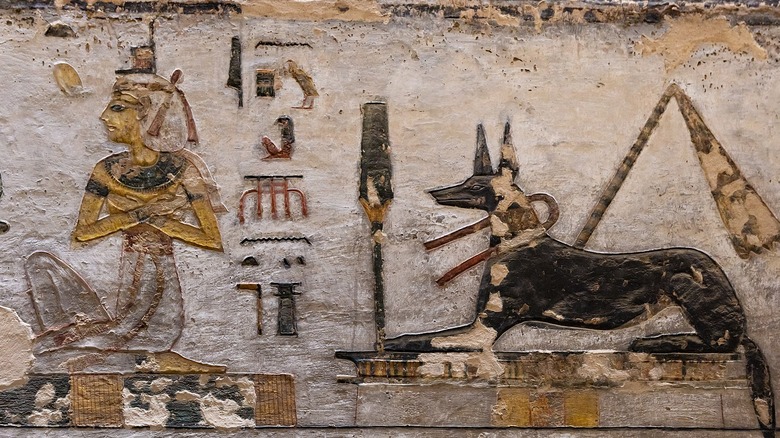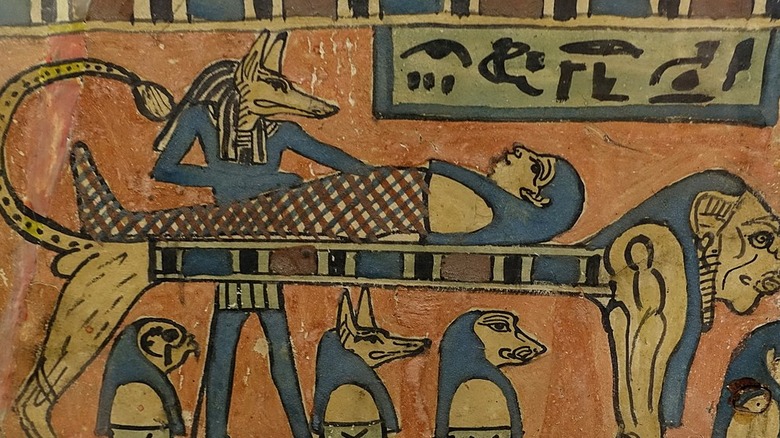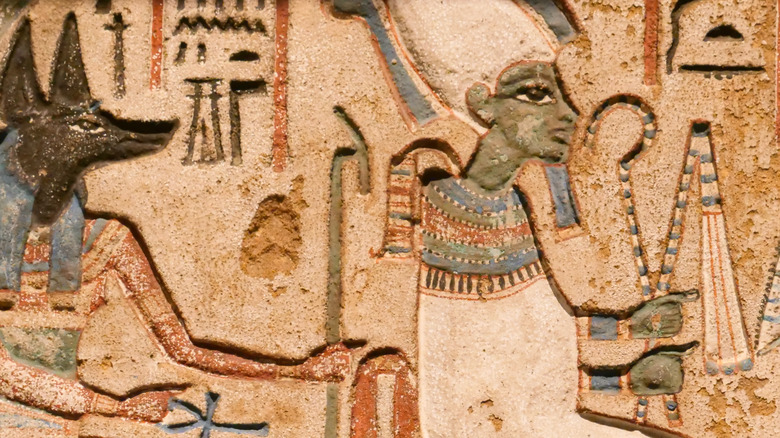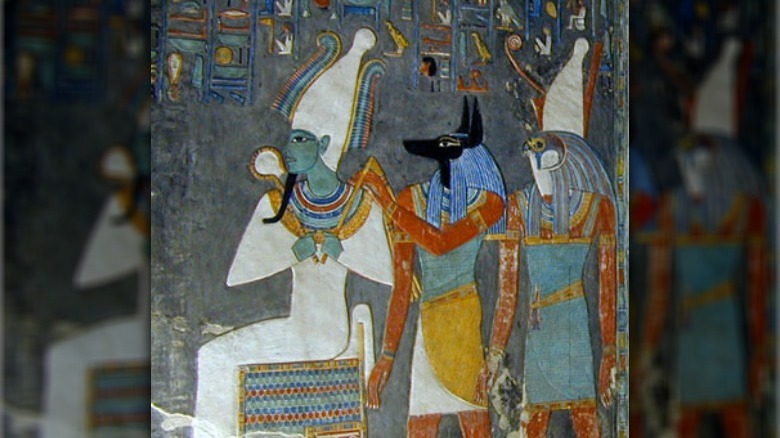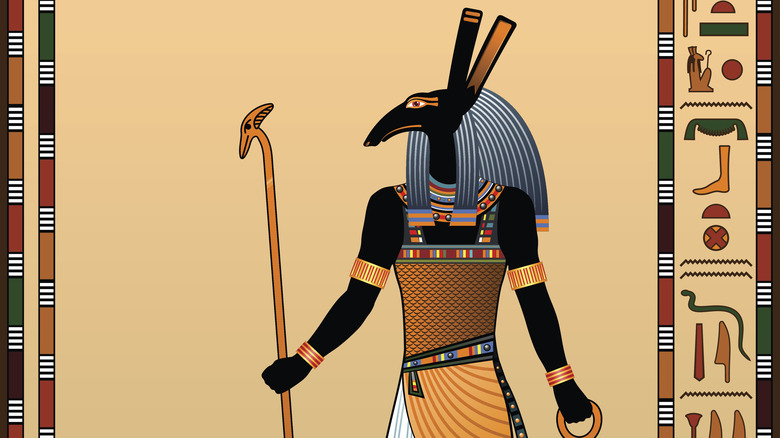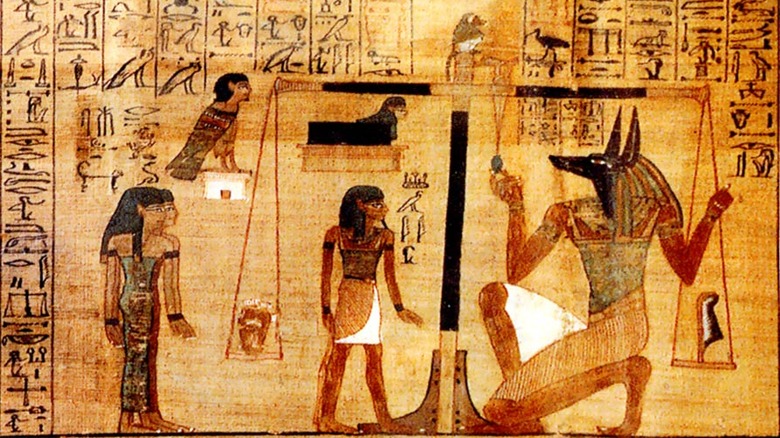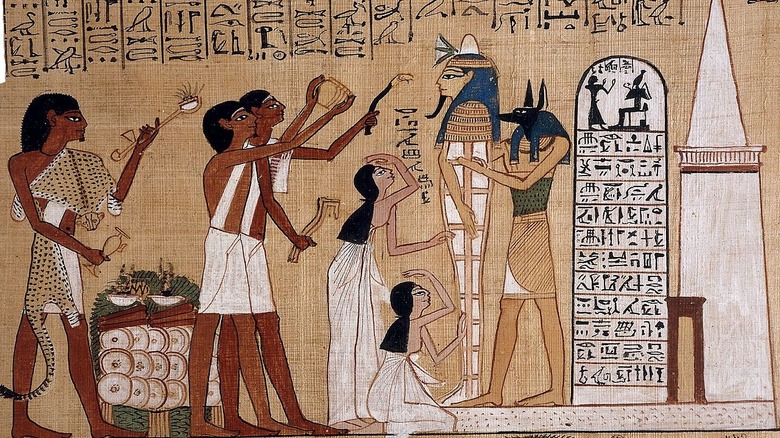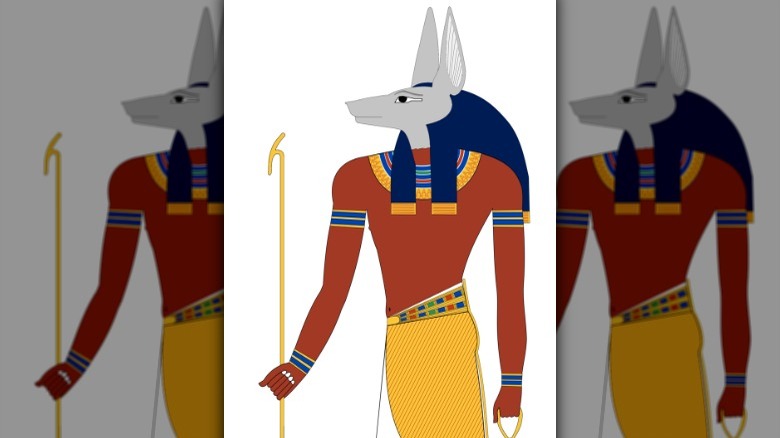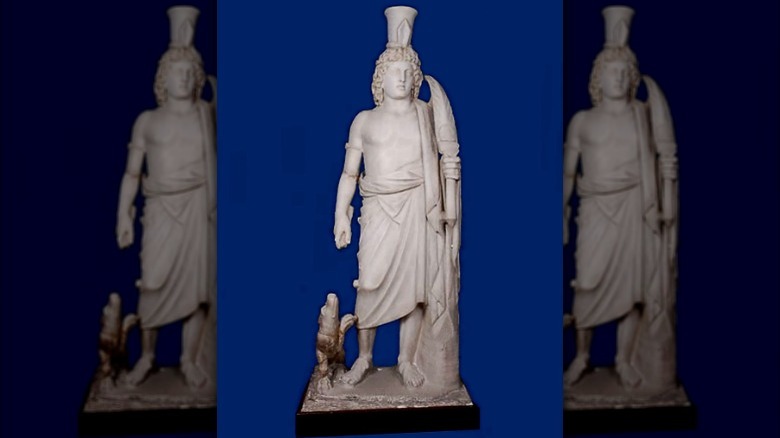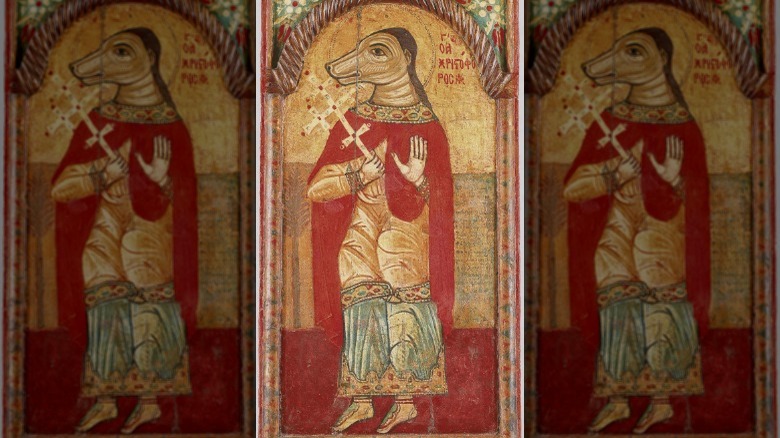The Egyptian God Of Death, Anubis, Explained
Death is a scary concept — that's a viewpoint that most people can understand, if not explicitly agree with. In its own way, it's also a difficult thing to fully comprehend, no matter what age you might be. So it makes a lot of sense that various different belief systems across different regions and across different times would have some way of explaining death and whatever may come after. Ancient mythologies are no different in that regard; the ancient Greeks and Romans had Hades (or Pluto), the great lord of the underworld, alongside other deities that had their own unique connections with the concept of death.
The ancient Egyptians similarly had a deity associated with death and the transition to the afterlife: the jackal-headed god named Anubis. Generally speaking, the image of Anubis is one that's persisted through time, with a lot of people nowadays probably being able to recognize the Egyptian god of death. But there are a few more details about this particular god than might be widely known. Here are just a few of them.
Anubis protected the dead, among other things
In case you didn't know too much about Anubis, well, here's a bit of a primer. Generally speaking, he's known as the jackal-headed (or dog-headed, depending on who you're listening to) Egyptian god of death. Typically, he's more specifically depicted with the head of a dark-headed jackal or dog, with that coloring relating both to the color of death, and also the color of life, as it resembled the soils of the Nile when it flooded (via World History Encyclopedia).
With that in mind, it does make some sense that Anubis' domain or area of influence is a bit wider than it might seem. See, he didn't rule over the afterlife — he wasn't Hades, if you'd like something of a comparison to Greek mythology — because that was actually the job of Osiris. Rather than the afterlife itself, he presided over funerary rites and mummifications — the journey that people took between life and whatever came after. He was the one to protect and guide people as they crossed over.
As such, he also ended up being associated with other concepts that were at least related in some way to death. One of those was the idea of justice, as he was the one to ensure that people were fairly judged after their death. Perhaps more interestingly though, he also became known for his connection to curses, both in terms of avoiding their terrifying effects, but also in laying them on others.
People looked to him for real-life protection
Anubis was the god that many people back in ancient Egypt looked to for protection in the afterlife. He would keep their soul safe as it traveled into the afterlife, but his role as a protector actually stretched a bit further beyond that.
As explained in Geraldine Pitch's "Egyptian Mythology," ancient Egypt had a bit of a problem when it came to burying bodies. Or, at least, the problem was with keeping the bodies buried. See, Egypt typically had a lot of jackals and dogs that would roam around the area, and they had quite a penchant for digging up those dead bodies. For obvious reasons, that wasn't exactly what the Egyptians wanted, and so they believed that by placating the jackal-headed god of death himself, their bodies would be kept safe from those wandering animals. Or World History Encyclopedia also suggests that this exact problem is precisely what prompted the ancient Egyptians to start worshiping Anubis in the first place.
But it wasn't just the local wildlife that caused issues. After all, tomb raiders weren't really an uncommon problem, and Anubis was also said to protect the dead and buried against them, punishing those who would dare invade.
Anubis' many names
Here's a fun little fact: The god that most modern folk know as Anubis actually had a different name in the past. Not only that, but he also had a whole lot of other names and titles, aside from just the one that everyone knows.
Taking it from the top, though, "Anubis" is actually the name given by the Greeks for the Egyptian god of death. The Egyptians themselves would've likely referred to him as "Anpu" or "Inpu," names which derive from the Egyptian term for decay (via World History Encyclopedia). Rather fitting for a god of death, isn't it? That said, Ancient Origins also adds that the names even share roots with terms related to royalty — a bit of a departure from the death motif.
It doesn't end there, though, as Anubis has held a truly impressive number of titles over time, including "Lord of the Sacred Land" (or nub-tA-djser), "He Who is in the Place of Embalming" (Imy-ut, in Egyptian), "The Dog Who Swallows Millions," among a whole host of others. There's one that he did lose, though. See, at first, he was called "First of the Westerners"; essentially, due to the movement of the Sun and its setting in the west, that direction was associated with death and the afterlife. So it only made sense that the god of death would be the first of those to travel to the west. But once Osiris rose in popularity and instead became the king of the dead, he took that particular title for himself.
Varying accounts of Anubis' parentage
You'd think that such a well-known god of an equally well-known pantheon of ancient gods would have a fairly clear origin story, right? That must be easy information to find and sort out. Except that in the case of Anubis, that's not quite what's going on.
Basically, according to the World History Encyclopedia, Anubis is a really old god, with evidence of his worship cropping up around 3000 B.C. in the form of scenes depicted on tombs (though scholars typically believe that his worship even dates back further than that). In line with that, older myths actually said that he was directly the son of Hesat and Ra — the powerful creator of the gods and the world in Egyptian mythology (via the Rosicrucian Egyptian Museum) — putting his origin right there at the beginning of the universe.
But mythologies can adapt and change over time. As the years passed, not only did Osiris become more popular, but he also began usurping Anubis, at least in terms of their relative places in the mythos. Osiris became the king of the dead and was generally tied more heavily to death, but Anubis still remained popular in the public eye. Just getting rid of him was out of the question, so they just changed his story. Instead, in the revised myths, Set's wife, Nepthys, was attracted to Osiris and tricked him into the affair that would result in Anubis' conception. Fearing retribution, she abandoned her son, only for Isis (Osiris' wife) to find the baby and raise him as her own.
The murder of Osiris
It's something of a strange thing, but if you're looking for specific myths that Anubis takes part in, you're actually not all too likely to find that many. So typically, when you go searching for Anubis, the main myth you find involves the murder of Osiris.
According to Geraldine Pitch's "Egyptian Mythology," there are also a number of different versions of this tale, but generally speaking, Osiris was named as the king of Egypt, and that didn't sit too well with his brother, Set. Of course, that could only mean one thing: Set just had to kill Osiris, dumping him in a river or scattering him into a bunch of pieces, depending on the version you're reading. Isis went to search for her husband and did manage to find him (or, most of him, rather), at which point the original stories said that she also revived him.
But then, the mythology changed slightly to incorporate Anubis into the tale. After the recovery of Osiris' body, Anubis was then called in, and as a funerary god, he took care of the rites. But he did more than that, performing the first ever mummification, setting in stone all of the spiritual aspects behind the real-life practice. That's not the end of it, either, as Set clearly wasn't happy with these developments, and he sent his followers out to try and destroy Osiris' body. Unfortunately for them, though, they had to contend with Anubis, who succeeded in standing guard over the body, keeping it safe.
He had multiple fights with Set
On the surface, Anubis not exactly getting along well with Set doesn't seem like too much of a surprise. After all, Set was responsible for the murder of Osiris, with whom Anubis worked closely and to who he was rather loyal. Still, the actual stories that came out of that antagonistic relationship are rather interesting.
According to Geraldine Pinch's "Egyptian Mythology," one version of the myth surrounding Osiris' murder actually had Set turning himself into a bull and using the strength of that animal to just stampede right over the brother he hated. In that telling of the story, Anubis was the one to seek out Set to administer justice, both bringing him to heel and also forcing him to carry the coffin of the very brother he had killed.
But that wasn't the only time that the two gods came to blows. Another old myth explains an event that occurred after Osiris' death, with Set taking on the form of a leopard to try and get close to the body, but unfortunately for him, Anubis happened to catch him in the act. A fight broke out between the two, and while Anubis apparently came out unscathed, Set wasn't so lucky, suffering brands on his skin from a hot iron. (Not to mention the fact that the god of death then chose to wear that skin as a rather gruesome warning.) Long story short: That's how ancient Egyptians explained a leopard's spots.
The Weighing of the Heart
When it comes to Anubis, it's hard to talk about him without also getting into the part of the mythology that he's perhaps most known for: the Weighing of the Heart of the Soul. As explained by World History Encyclopedia, there's a rather specific image that people probably know best, with Anubis himself holding the legendary scales, balancing the heart of the dead against the Feather of Truth.
In actuality, though, the ceremony was a bit more complex than that. For one, despite Anubis' association with justice, he wasn't the only god involved in this entire affair (via World History Encyclopedia). Anubis was the one to guide souls from life into death, but upon crossing that particular threshold, those souls were instead seen to by a small host of other gods, including Qebhet, Nephthys, and Serket. And when it was their turn to learn their fate, Anubis would again show his face, this time to escort them into the Hall of Truth, in which sat Thoth, Ma'at, and Osiris himself. After a number of confessions, the heart would be taken by Osiris and weighed against the feather; hearts lighter than the feather were allowed to pass into the bliss of the Field of Reeds, but those heavy with sin were completely erased from existence.
The Opening of the Mouth ritual
In general, Anubis is associated not just with the dead, but with funerary rituals and mummification, given his part in preparing the body of Osiris after his death. But when it comes to ritualistic practices, embalming and mummifying a body were only part of the process, and Anubis is related to that later (and vitally important) step — something called the Opening of the Mouth ritual (via Geraldine Pinch's "Egyptian Mythology").
Essentially, a body being embalmed and mummified didn't necessarily mean it had already passed into the afterlife. Instead, during that time, the spirit of the deceased was in something of a state of limbo, unable to actually utilize any of its senses (via the University of Illinois Urbana-Champaign). Even if, hypothetically, it had passed into the afterlife, that spirit wouldn't be able to enjoy any of the pleasures that this new life had to offer. Food, drink, beautiful sights — all of it would be lost for that spirit. The Opening of the Mouth ceremony was the solution to that problem. One of Anubis' priests — representing the god himself — would perform a ritual on the body, touching its mouth with specific instruments. Doing so would return the senses to the dead, ensuring that they could properly move on and experience the afterlife.
He wasn't the only jackal-headed god
You'd think that a god having a jackal or dog head would be a pretty distinguishing feature, right? After all, how many gods could all have that exact same detail? There couldn't be any way to mix that up. Except that in Egyptian mythology alone, there are actually multiple gods who fit this particular description. Strange, isn't it?
Most prominent was the god that closest resembles Anubis in quite a few different ways: Wepwawet. Frankly, on the surface, it's pretty difficult to differentiate the two. According to Barbara Watterson's "The Gods of Ancient Egypt," Wepwawet was frequently portrayed with the head of a jackal and was known widely as the "the Opener of the Ways," a particular reference to his job description of leading dead souls on their way to the afterlife.
So how would anyone know that they're even two different gods? Well, per Margaret R. Bunson's "The Complete Gods and Goddesses of Ancient Egypt," some sources say that he was more than a guide for the dead, but also the god who drove the sun chariot — albeit, he didn't drive it through the day, but instead was the one responsible for it when night fell. His actual physical description is also a tad different from that of Anubis. Wepwawet's head was typically a lighter color than Anubis' head. Moreover, he's occasionally referred to as the wolf god, leading to the belief that he was originally depicted with a wolf-head, and over time, his image was just made to match that of Anubis.
Anubis and Greco-Roman mythology
So, yes, Anubis is a major member of the Egyptian pantheon of gods, and that's markedly different from the Greco-Roman gods of antiquity. But here's the strange thing: There's actually not quite as much of a divide between those two mythologies as you might initially think. After all, Ovid (via Theoi) even recounts a myth in which the Greco-Roman gods fled from their homeland and took up refuge in Egypt, wearing animal heads as disguises. Thus, the Egyptian gods were created.
Anubis isn't explicitly mentioned in those myths, but he did manage to transcend time and merge with Greco-Roman beliefs more directly. Per Rhakotis, the Greeks and Romans took a particular liking to Anubis, seeing similarities between him and their own messenger god, Hermes, both of them playing a role in mortals' journeys from the land of the living to that of the dead. Because of that, they merged the two deities together, creating something of a composite god that they called Hermanubis. Fittingly, the depiction of this god is a rather literal combination of the two gods: a jackal-headed figure oftentimes holding a caduceus, the staff heavily associated with Hermes, or wearing the famous winged sandals of the messenger god.
Other Roman depictions occasionally iterated on that idea, instead depicting him in a fully human form as a dog circled at his feet (via Historia: Zeitschrift für Alte Geschichte). Beyond that, though, in some locations, he found new followers as a member of the trio of gods worshiped by the Roman Isis cult.
A counterpart in Christianity
Generally speaking, you'd think that when it comes to systems of belief that there wouldn't be that much overlap between ancient mythologies and Christianity. Here's the strange thing, though: There is actually a rather specific connection.
To get more specific about it, Anubis' connection to Christianity comes in the form of Saint Christopher, who is often portrayed with a dog head, per an article published in Historia: Zeitschrift für Alte Geschichte. This particular saint seemed to originate somewhere in the fifth or sixth century, and the most common tale says that Christopher — born in an unspecified foreign land as Offerus — was known for his incredible strength. Almost fittingly, he decided that strength would be the deciding factor to who he was willing to pledge his allegiance, but as a result, neither hell nor earth could satisfy him in that regard. Eventually, he agreed to convert to Christianity and agreed to carry people across a raging river — one of whom turned out to be Christ himself. And that's the image that he's most commonly known for, which has been tied to resurrection.
Anubis falls into a very similar space, with some depictions of him rather literally carrying Osiris during his own partial resurrection. Now, as to whether or not Anubis actually inspired or is Saint Christoper — that's hard to say, and there's debate on the topic, but the physical and thematic similarities are definitely interesting.
